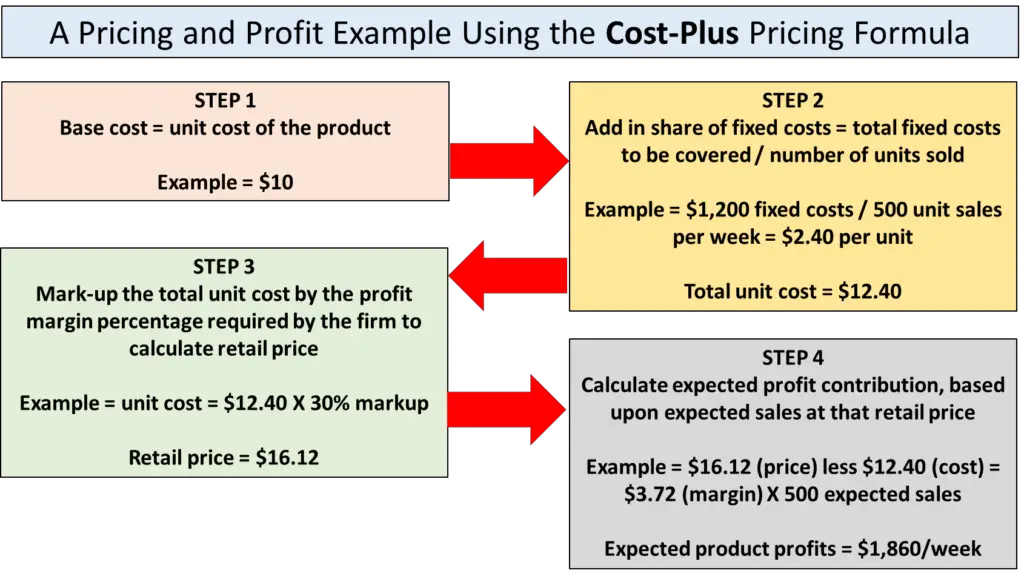Scroll down for the free cost-plus Excel template…
Contents
What is Cost-plus Pricing?
Cost-plus pricing is a pricing approach that marks up the firm’s product costs by a percentage. This percentage is designed to cover costs and to generate sufficient profitability.
Because the firm is adding a percentage mark-up, this pricing approach is sometimes also referred to as mark-up pricing.
Please see this article for further information on cost-plus pricing = Cost-Plus Pricing Formula with Examples.
Download the Free Cost-plus Pricing Formula Excel Template
When dealing with multiple products that have different unit costs and different required markup percentages, as well as allocating fixed costs across product lines, cost-plus pricing can become somewhat complex.
To assist in this regard and to aid understanding of this pricing approach and its formula, the Marketing Study Guide has developed an easy to use Excel template, which is free to download and does not require any sign-up.
In addition to being quick and easy to use, this Excel template is also the ideal tool for scenario testing of different price points and markups. As with most elements of the marketing mix, we tend to look at different pricing scenarios as well – so this spreadsheet will make that task a lot easier.
For how to use the cost-plus template, please see the video below.
- You can download your free template here … cost-plus-pricing-formula-excel-template
How To Use the Cost-Plus Pricing Excel Template Video
Steps to Use the Cost-Plus Pricing Template
- STEP 1: INPUT TOTAL FIXED COSTS
- STEP 2: ALLOCATE FIXED TOTAL COSTS
- STEP 3 (Automated): Value of Costs per Product
- STEP 4: ESTIMATED/ACTUAL SALES VOLUME
- STEP 5 (Automated): Share of FIXED Costs per Unit Sold
- STEP 6: ENTER VARIABLE COSTS
- STEP 7 (Automated): Total Cost per Product Unit
- STEP 8: ENTER % MARK-UP
- STEP 9 (Automated): Final Price
- STEP 10 (Automated): Key Pricing and Profit Metrics
As you can see, there are 5 input steps and 5 automated (output) steps, making the template very easy and fast to use.
Tips on Using the Cost-Plus Pricing Excel Template
- Follow the 10 Steps in sequence – some steps are automated and will calculate as you enter data
- The 10 Steps are highlighted in YELLOW
- You can enter data for up to 10 products
- Enter data in the BLUE cells only – all other cells are protected for safety
- If you do not wish use fixed costs, go to Step 4, then complete Steps 6-10
- You can use any time period, provided that you are consistent across all inputs
- Final price and various metrics are provided in Steps 9 and 10
- For more information on cost-plus pricing, please see the information and related articles below
A quick guide to the cost-plus pricing formula and approach
A full detailed example, plus other examples, are available on this website at:
Alternatively you can review the following diagram and the below information, which shows you the steps involved in cost-plus pricing:
Quick FAQs on Cost-plus Procing
What is cost-plus pricing?
Cost-plus pricing is a pricing strategy where the selling price of a product is determined by adding a specific markup percentage to the unit cost of the product. This markup represents the profit margin per unit.
How is cost-plus pricing calculated?
If the costs of a product total, say, $10, and an 80% markup is applied, then the retail price to the consumer becomes $18. Here, the seller makes an $8 profit per unit sale. This is a straightforward way to calculate prices.
Why is cost-plus pricing suitable for businesses with many products?
Cost-plus pricing is particularly useful for businesses with numerous unique product units. By applying generic markup percentages for different product categories, a large-scale retailer can manage pricing for large numbers of units.
How does cost-plus pricing ensure profitability?
Cost-plus pricing ensures profitability by including all costs of production and supply, along with a profit margin, in the selling price. However, it’s important to note that the calculation should include all variable and fixed costs and is based on expected sales volumes. If sales volumes are maintained, cost-plus pricing will ensure continuous profits.
How does cost-plus pricing respond to changing costs?
Businesses can adjust cost-plus prices fairly easily in response to changing costs. By altering the cost inputs in their pricing model, businesses can then adjust their selling prices accordingly. However, prices should not be adjusted too frequently, as doing so can lead to customer dissatisfaction.
How does cost-plus pricing help with business planning and forecasting?
Cost-plus pricing can enhance business planning and forecasting by providing a reliable method for calculating prices and profits. This approach enables businesses to test different cost scenarios and assess their potential impact on prices, profit margins, and sales.
However, it’s important to also consider factors such as competitors, customers, different segments, and other environmental changes when forecasting.
Does cost-plus pricing ensure a profit on every sold unit?
Yes, as long as the cost calculations are correct and sales volumes are maintained, cost-plus pricing ensures a profit margin on every sold unit. The strategy works on the premise that every cost, fixed and variable, is included in the product price along with a profit margin.
Related Information
- When to Use Cost-Plus Pricing
- Disadvantages of Cost-Plus Pricing
- More Cost-Plus Pricing Examples
- A Model of Reference Prices
- Prices, costs, margins and purchase quantity
- Free PESTLE Analysis Template
- How to Use the Free BCG Matrix Template
- Free Customer Journey Map Excel Template
- Free Download: ATAR Model Excel Template

